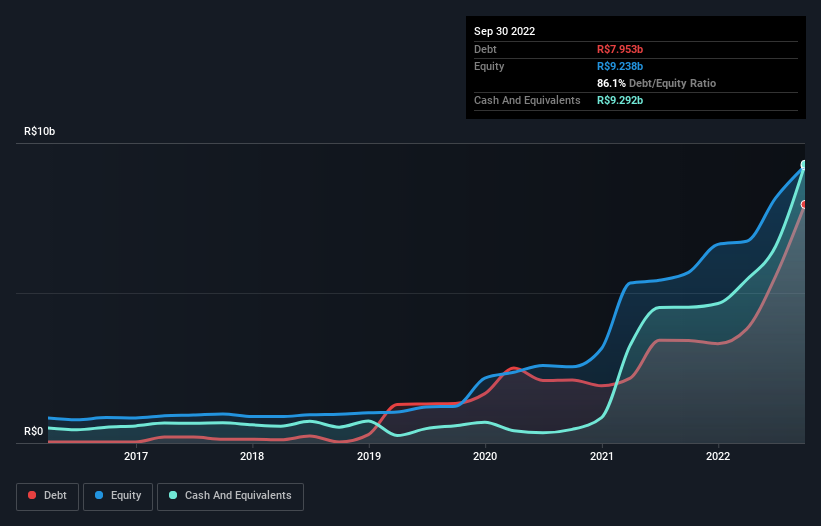
The external fund manager backed by Berkshire Hathaway's Charlie Munger, Li Lu, makes no bones about it when he says 'The biggest investment risk is not the volatility of prices, but whether you will suffer a permanent loss of capital.' So it seems the smart money knows that debt - which is usually involved in bankruptcies - is a very important factor, when you assess how risky a company is. As with many other companies Petro Rio S.A. (BVMF:PRIO3) makes use of debt. But is this debt a concern to shareholders?
When Is Debt Dangerous?
Generally speaking, debt only becomes a real problem when a company can't easily pay it off, either by raising capital or with its own cash flow. Ultimately, if the company can't fulfill its legal obligations to repay debt, shareholders could walk away with nothing. However, a more common (but still painful) scenario is that it has to raise new equity capital at a low price, thus permanently diluting shareholders. Of course, plenty of companies use debt to fund growth, without any negative consequences. When we think about a company's use of debt, we first look at cash and debt together.
View our latest analysis for Petro Rio
What Is Petro Rio's Net Debt?
The image below, which you can click on for greater detail, shows that at September 2022 Petro Rio had debt of R$7.95b, up from R$3.42b in one year. But it also has R$9.29b in cash to offset that, meaning it has R$1.34b net cash.

How Healthy Is Petro Rio's Balance Sheet?
We can see from the most recent balance sheet that Petro Rio had liabilities of R$1.42b falling due within a year, and liabilities of R$9.26b due beyond that. Offsetting these obligations, it had cash of R$9.29b as well as receivables valued at R$1.13b due within 12 months. So its liabilities total R$260.4m more than the combination of its cash and short-term receivables.
Having regard to Petro Rio's size, it seems that its liquid assets are well balanced with its total liabilities. So while it's hard to imagine that the R$28.6b company is struggling for cash, we still think it's worth monitoring its balance sheet. While it does have liabilities worth noting, Petro Rio also has more cash than debt, so we're pretty confident it can manage its debt safely.
Even more impressive was the fact that Petro Rio grew its EBIT by 118% over twelve months. If maintained that growth will make the debt even more manageable in the years ahead. There's no doubt that we learn most about debt from the balance sheet. But ultimately the future profitability of the business will decide if Petro Rio can strengthen its balance sheet over time. So if you want to see what the professionals think, you might find this free report on analyst profit forecasts to be interesting.
But our final consideration is also important, because a company cannot pay debt with paper profits; it needs cold hard cash. While Petro Rio has net cash on its balance sheet, it's still worth taking a look at its ability to convert earnings before interest and tax (EBIT) to free cash flow, to help us understand how quickly it is building (or eroding) that cash balance. Looking at the most recent three years, Petro Rio recorded free cash flow of 30% of its EBIT, which is weaker than we'd expect. That weak cash conversion makes it more difficult to handle indebtedness.
Summing Up
We could understand if investors are concerned about Petro Rio's liabilities, but we can be reassured by the fact it has has net cash of R$1.34b. And it impressed us with its EBIT growth of 118% over the last year. So is Petro Rio's debt a risk? It doesn't seem so to us. When analysing debt levels, the balance sheet is the obvious place to start. But ultimately, every company can contain risks that exist outside of the balance sheet. These risks can be hard to spot. Every company has them, and we've spotted 1 warning sign for Petro Rio you should know about.
At the end of the day, it's often better to focus on companies that are free from net debt. You can access our special list of such companies (all with a track record of profit growth). It's free.
New: Manage All Your Stock Portfolios in One Place
We've created the ultimate portfolio companion for stock investors, and it's free.
• Connect an unlimited number of Portfolios and see your total in one currency
• Be alerted to new Warning Signs or Risks via email or mobile
• Track the Fair Value of your stocks
Have feedback on this article? Concerned about the content? Get in touch with us directly. Alternatively, email editorial-team (at) simplywallst.com.
This article by Simply Wall St is general in nature. We provide commentary based on historical data and analyst forecasts only using an unbiased methodology and our articles are not intended to be financial advice. It does not constitute a recommendation to buy or sell any stock, and does not take account of your objectives, or your financial situation. We aim to bring you long-term focused analysis driven by fundamental data. Note that our analysis may not factor in the latest price-sensitive company announcements or qualitative material. Simply Wall St has no position in any stocks mentioned.
About BOVESPA:PRIO3
Prio
Engages in the exploration, development, and production of oil and natural gas properties in Brazil and internationally.
Very undervalued with high growth potential.


